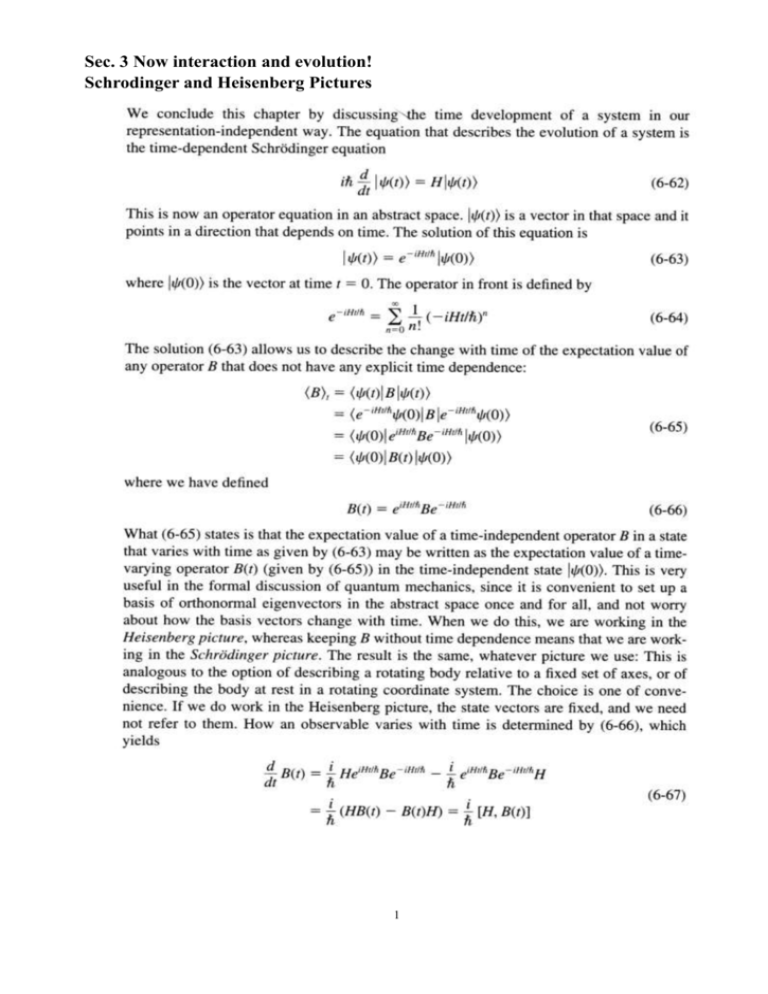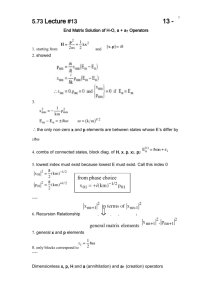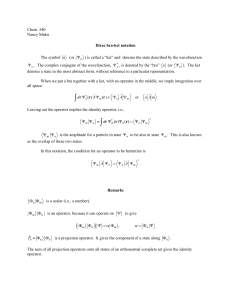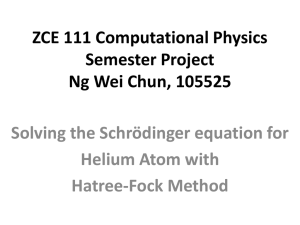notation hence
advertisement

Sec. 3 Now interaction and evolution! Schrodinger and Heisenberg Pictures 1 Interaction and Interaction Picture The interactions are introduced into QFT when we add additional terms into the Lagrangian beyond what we have in a free field theory: For example, we can add 3 ( x), 4 ( x), ( x) ( x) ( x) to our Klein-Gordon or Dirac Lagrangian. Notice they must be Lorentz invariant. These interactions will generate additional terms in the Hamiltonian. In most cases (when interaction contains no derivatives), the additional Hamiltonian is just the negative of the interaction Lagrangian : To analyze the effects of the interaction, it’s convenient to work in a picture called interaction picture, which lies between Heisenberg picture and Schrodinger picture. The full Hamiltonian can be separated into two parts: H H 0 H int In the transforming from Schrodinger picture to Heisenberg picture: we can stop in the middle by replacing the e iHt / in the above formula with e iH t / . 0 Hence both the states and the operators will evolve with time: OI (t ) eiH0t / OS e iH0t / S Operators evolve just like operators in the Heisenberg picture but with the full Hamiltonian replaced by the free Hamiltonian: dOI i H 0 , OI dt It applies also to the field operators: 2 d i H 0 , dt Hence field operators are free, as if there is no interaction! Hence all the things we derived about the Klein-Gordon free Fields in Heisenberg picture in Sec 2.4 still work here for the field operators in the interaction picture! Especially the expansion of field and its dependence on time are valid. For the evolution of states: æ iö d y I (t) = ç - ÷ H I y I (t) è ø dt So the states in the interaction picture evolve like in the Schrodinger picture but with Hamiltonian replaced by UI (t). This term is just the interaction Hamiltonian Hint in interaction picture! That means the field operators in UI (t) are free, ie. evolving as if there is no interaction! So the states now evolve by the interaction Hamiltonian UI (t) with free fields: d i I (t ) H I I (t ) dt The time evolution can be integrated into a unitary operator U I (t ) U (t , t0 ) I (t0 ) All the problems can be answered if we are able to calculate this operator. From the evolution of states, we can find the evolution equation of U (From now on we assume =1): d d yI (t) = (U(t, t0 ) yI (t0 ) ) = -i H I (U(t, t0 ) yI (t0 ) dt dt ) 𝑑 𝑈(𝑡, 𝑡0 ) = −𝑖 𝐻I ∙ 𝑈(𝑡, 𝑡0 ) 𝑑𝑡 In QFT, it is usually calculated by a perturbation expansion in small parameters in HI. 3 U (t , t 0 ) U ( 0) (t , t 0 ) U (1) (t , t 0 ) The interaction Hamiltonian is considered order one HI(1). Plug this expansion into the above evolution equation, we can solve it order by order. Note that the zeroth order of U is actually 1. U ( 0) (t , t 0 ) 1 . Keep terms to the leading order: 𝑑 (1) 𝑈 (𝑡, 𝑡0 ) = −𝑖 𝐻I ∙ 𝑈 (0) (𝑡, 𝑡0 ) = −𝑖𝐻I (𝑡) 𝑑𝑡 𝑡 𝑈 (1) (𝑡, 𝑡0 ) = −𝑖 ∫ 𝑑𝑡 ′ 𝐻I (𝑡′) 𝑡0 U(t, t0 ) is the operator that describes the evolution of the system from t0 to t . Setting the initial time 0 instead to negative infinity and the final time 𝑡 = ∞, it will describe the scattering and decay process of particle physics that evolve a state in the long past into another state in the long future. ∞ 𝑈 (1) (∞, −∞) = −𝑖 ∫ 𝑑𝑡′ 𝐻I (𝑡′) −∞ We define the resultant operator as S: 𝑆 ≡ 𝑈𝐼 (−∞, ∞). For example, the leading order of S is: ∞ 𝑆 (1) ∞ ∞ 3 = −𝑖 ∫ 𝑑𝑡 𝐻I (𝑡) = −𝑖 ∫ 𝑑𝑡 ∫ 𝑑 𝑥⃗ ℋI (𝑥⃗, 𝑡) = 𝑖 ∫ 𝑑 4 𝑥 ℒI (𝑥) −∞ −∞ −∞ 4 Vertex We now consider the ABC model in Griffiths’s book Ch. 6. Each particle will be associated with a field with its Free Scalar Lagrangian as described above. Let’s call the field of A particle as 𝐴(𝑥) etc. Till now the theory is free, ie particle do not interact. To introduce interaction, we need to add additional terms in the Lagrangian beyond the free scalar Larangian. Let’s add a term: ℒ𝐼 = 𝑔𝐴(𝑥)𝐵(𝑥)𝐶(𝑥). This is Lorentz invariant. The interaction Hamiltonian is ℋI = −ℒ𝐼 . For free quantum fields, particles do not interact since their states are energy eigenstates and do not evolve. This additional term introduces interaction. As an example, now we calculate the transition amplitude for the decay process 𝐴(𝑝⃗1 ) → 𝐵(𝑝⃗2 ) + 𝐶(𝑝⃗3 ). The initial state is |𝐴⟩ while the final state is |𝐵𝐶⟩. To the leading order, S is ∞ 𝑆 = −𝑖 ∫−∞ 𝐻𝐼 = −𝑖 ∫ 𝑑𝑡𝑑 3 𝑥 ℋ𝐼 = 𝑖 ∫ 𝑑𝑡𝑑 3 𝑥 ℒ𝐼 = 𝑖 ∫ 𝑑 4 𝑥 𝑔𝐴(𝑥)𝐵(𝑥)𝐶(𝑥). Look, again it’s Lorentz invariant. The transition amplitude is then ⟨𝐵𝐶|𝑖𝑔 ∫ 𝑑 4 𝑥 𝑔𝐴(𝑥)𝐵(𝑥)𝐶(𝑥) |A⟩. Now each field operator is a linear combination of an annihilation operator and a creation operator. The A Particle in the initial state can be annihilated by the annihilation operator of A (with momentum p1). For example: |𝑘⟩ = √2𝜔𝑘 𝑎𝑘† |0⟩ ⃗⃗ − ⃗⃗⃗⃗ 𝑎𝑘′ |𝑘⟩ = √2𝜔𝑘 𝑎𝑘 ′ 𝑎𝑘† |0⟩ = √2𝜔𝑘 [𝑎𝑘 ′ , 𝑎𝑘† ]|0⟩ = √2𝜔𝑘 (2𝜋)3 𝛿 3 (𝑘 𝑘′) Similarly the particles B and C in the final state can be created from vacuum by the creation operators of B and C (with momenta p2 and p3 respectively). Expanding the product ABC by creation and annihilation operators will give you 8 terms. But 7 terms will vanish. Only one term will give you the right combination and a nonzero result in the amplitude: ⟨𝐵𝐶|𝑖 ∫ 𝑑 4 𝑥 𝑔𝐴(𝑥)𝐵(𝑥)𝐶(𝑥) |A⟩ . † † 𝑎⃗⃗⃗⃗⃗ 𝑝1 𝑎 ⃗⃗⃗⃗⃗ 𝑝2 𝑎 ⃗⃗⃗⃗⃗ 𝑝3 The momenta of the annihilation and creation operator must match the momenta of the particles it annihilates or creates. After creation and annihilation, a numerical factor is left behind from the field operator expansion ò d3 p 2w P ( 2p ) 3 ( â p × e-ip×x + â+p × eip×x ) : 5 𝑖𝑔 ∫ 𝑑 4 𝑥 𝑒 −𝑖𝑝1𝑥 𝑒 𝑖𝑝2𝑥 𝑒 𝑖𝑝3𝑥 = 𝑖𝑔 ∫ 𝑑 4 𝑥 𝑒 −𝑖(𝑝1 −𝑝2−𝑝3)𝑥 = 𝑖𝑔𝛿 4 (𝑝1 − 𝑝2 − 𝑝3 ). This is just the famous Feynman rule for a vertex. For a vertex, we have the coupling constant times the total momentum conservation. So roughly speaking, an interaction Lagrangian term corresponds to a vertex, with each field operator in the interaction corresponds to a leg in the vertex. So the vertex can be read directly from the interaction term in the Lagrangian:ℒ𝐼 . And since each field operator can either create or annihilate a particle, a leg in the vertex can mean both creation or annihilation of a particle, depending on the process you are studying. The same consideration can apply to other interactions. For example , LI = lf 4 would give a vertex and the Feynman rule is iλ . 6 Propagator Let’s now consider the scattering process A A B B in the ABC model. It won’t happen in the leading order expansion of U. We have to calculate U to the second order in g. In interaction picture: the time evolution operator U satisfies: 𝑑 𝑈(𝑡, 𝑡0 ) = −𝑖 𝐻I ∙ 𝑈(𝑡, 𝑡0 ) 𝑑𝑡 To the second order of the g, we only need to consider the U on the right hand side to the first order of g, which we solved already. Hence 𝑡 𝑑 (2) 𝑈 (𝑡, 𝑡0 ) = −𝑖 𝐻I ∙ 𝑈 (1) (𝑡, 𝑡0 ) = −𝐻I (𝑡) ∙ ∫ 𝑑𝑡 ′ 𝐻I (𝑡′) 𝑑𝑡 𝑡0 U(2) can be easily solved as: 𝑡 𝑡 𝑡′′ 𝑡′′ 𝑈 (2) (𝑡, 𝑡0 ) = − ∫ 𝑑𝑡′′ [𝐻I (𝑡′′) ∙ ∫ 𝑑𝑡 ′ 𝐻I (𝑡′)] = − ∫ 𝑑𝑡 ′′ ∫ 𝑑𝑡 ′ 𝐻I (𝑡′′) ∙ 𝐻I (𝑡′) 𝑡0 𝑡0 𝑡0 𝑡0 It’s the integration of the product of two interaction Hamiltonian HI. Notice from the integration range that the first HI is always later than the second HI. However, the integration variables t’ and t’’ are just dummy notations and can be exchanged. Hence 𝑡 𝑈 (2) (𝑡, 𝑡′′ 𝑡 𝑡′ 1 𝑡0 ) = − [ ∫ 𝑑𝑡 ′′ ∫ 𝑑𝑡 ′ 𝐻I (𝑡′′) ∙ 𝐻I (𝑡′) + ∫ 𝑑𝑡 ′ ∫ 𝑑𝑡 ′′ 𝐻I (𝑡′) ∙ 𝐻I (𝑡′′)] 2 𝑡0 𝑡0 𝑡0 𝑡0 Now we are in fact integrating over the whole square while always keep the later (in time) H first in the product. t’’ ttT tt t’ We can rewrite this instead as: 𝑡 𝑡 𝑡0 𝑡0 1 𝑈 (2) (𝑡, 𝑡0 ) = − ∫ 𝑑𝑡 ′′ ∫ 𝑑𝑡 ′ 𝑇[𝐻I (𝑡′′) ∙ 𝐻I (𝑡′)] 2 The notation “time ordered” T means the earlier operator will be automatically put to the right, ie: 𝑇[𝐴(𝑡1 ) ∙ 𝐵(𝑡2 )] = 𝜃(𝑡1 − 𝑡2 )𝐴(𝑡1 ) ∙ 𝐵(𝑡2 ) + 𝜃(𝑡2 − 𝑡1 )𝐴(𝑡2 ) ∙ 𝐵(𝑡1 ) 7 This notation seems strange and artificial, but you will see what its physical meaning later. Now the S matrix can be written and we plug in: The S matrix becomes: 𝑆 (2) ∞ ∞ −∞ −∞ 1 = 𝑈 (2) (∞, −∞) = − ∫ 𝑑4 𝑥1 ∫ 𝑑 4 𝑥2 T[ℒI (𝑥1 ) ∙ ℒI (𝑥2 )] 2 Here LI’s are the interaction Lagrangian. Again, this is explicitly Lorentz invariant if LI is Lorentz invariant. For the scattering 𝐴(𝑝⃗1 ) + 𝐴(𝑝⃗2 ) → 𝐵(𝑝⃗3 ) + 𝐵(𝑝⃗4 ), the amplitude can be calculated as: B( p3 ) B( p4 ) S A( p1 ) A( p2 ) B( p3 ) B( p 4 ) d 4 x1 d 4 x 2 T g A( x1 ) B( x1 ) C ( x1 ) gA( x 2 ) B( x 2 ) C ( x 2 ) A( p1 ) A( p 2 ) d 4 x1 d 4 x 2 e i ( p1 p3 ) x2 e i ( p2 p4 ) x1 0 T C ( x1 ) C ( x 2 ) 0 As in the leading order calculation, the particle A(p1) is annihilated at x2 and A(p2) is annihilated at x1. The particle B(p3) is created at x2 and B(p4) is created at x1.The remaining object 0 T C( x1 ) C( x2 ) 0 is called the propagator. When t1 t 2 ,the creation operator in the operator C(x2) appearing to the right will create a C particle at x2 and it will be annihilated at x1 by the annihilation operator in C(x1) appearing to the left. When t 2 t1 and the order of operators is reversed, the operator C(x1) appearing to the right will create a C particle at x1 and it will be annihilated at x2 by C(x2) appearing to the left. This construction ensures causality of the process. It is actually the sum of two possible but exclusive processes. 8 B(p3) B B B B(p4) B x1 x2 C(p1-p3) x2 C A x1 C A A A A(p1) A(p2) This propagator looks reasonable in coordinate space but difficult to calculate and the formula is cumbersome. ⟨0|𝑇[𝜙(𝑥) ∙ 𝜙(𝑦)]|0⟩ Sandwiched between two vacua, only the third term will survive: ⟨0|𝑇[𝜙(𝑥) ∙ 𝜙(𝑦)]|0⟩ 0 T ( x∙)𝜙(𝑦)]|0⟩ ( y) 0 ⟨0|𝑇[𝜙(𝑥) ⟨0|𝑇[𝜙(𝑥) ∙ 𝜙(𝑦)]|0⟩ The propagator is Lorentz invariant. But this form is not obviously Lorentz invariant. 9 So an even more useful form is obtained by extending the integration to 4-momentum. And in the momentum space (ie. the Fourier Transform of the propagator), it becomes extremely simple: d 4 x1 d 4 x2 e ipx1 e iqx2 0 T C ( x1 ) C ( x2 ) 0 i 4 ( p q) 2 q mC 2 The delta function serves to make sure the momentum flowing into the particle is just the momentum flowing out. This is just the famous Feynman rule of an internal line. 10








